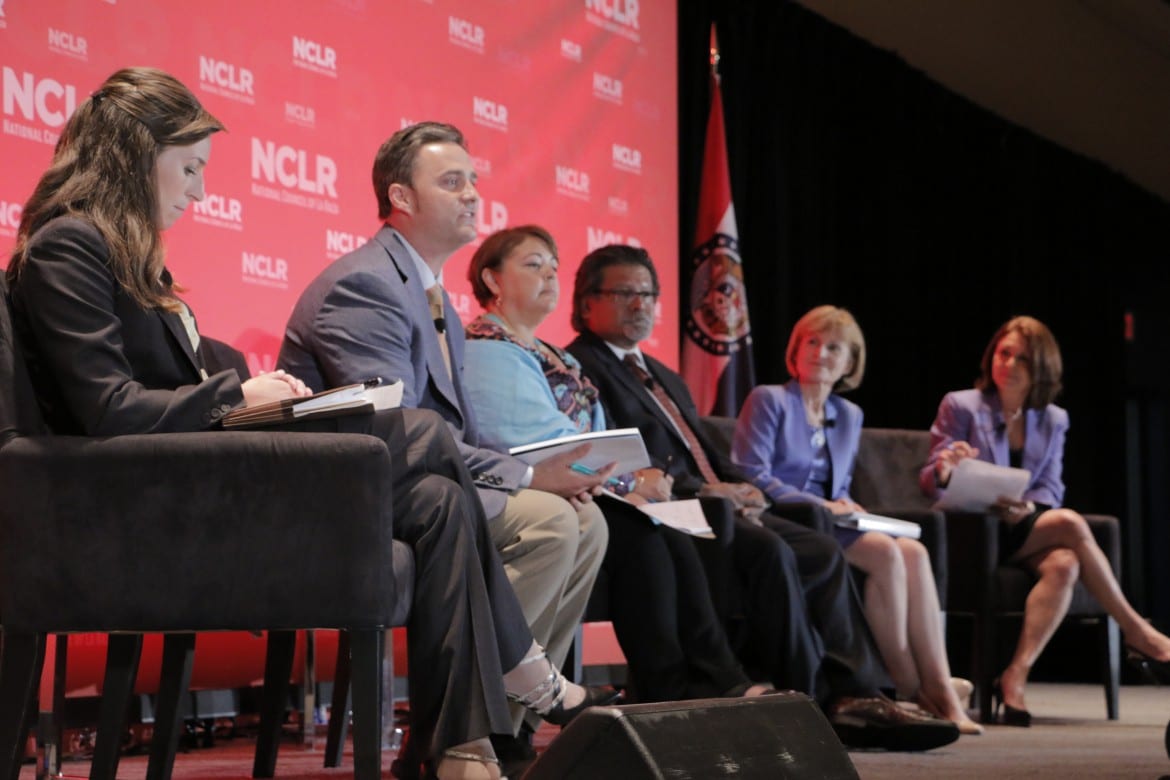La Raza Panel: Zip Codes Key To Understanding Community Health
 Patrick Brosnan (second from left), executive director of the Brighton Park Neighborhood Council in Chicago, spoke during a Monday health panel at the National Council of La Raza conference in Kansas City, Missouri. Also pictured (from left to right) were Shannon Bagley of Home State Health in Chesterfield, Missouri; Genoveva Islas of Cultiva La Salud in Fresno, California; John Govea of the Robert Wood Johnson Foundation in Princeton, New Jersey; Mary Wakefield of the U.S. Department of Health and Human Services in Washington, D.C.; and Marisa Azaret of CNN en Espanol. (Photo by Mike Sherry/The Hale Center for Journalism)
Patrick Brosnan (second from left), executive director of the Brighton Park Neighborhood Council in Chicago, spoke during a Monday health panel at the National Council of La Raza conference in Kansas City, Missouri. Also pictured (from left to right) were Shannon Bagley of Home State Health in Chesterfield, Missouri; Genoveva Islas of Cultiva La Salud in Fresno, California; John Govea of the Robert Wood Johnson Foundation in Princeton, New Jersey; Mary Wakefield of the U.S. Department of Health and Human Services in Washington, D.C.; and Marisa Azaret of CNN en Espanol. (Photo by Mike Sherry/The Hale Center for Journalism)
Published July 13th, 2015 at 4:53 PM
Something as simple as schoolyard gates can play a role in improving the health of low-income communities.
At least that’s what activists in California’s San Joaquin Valley found, according to Genoveva Islas, director of Cultiva La Salud, a Fresno-based organization that means “cultivate health” in Spanish.
Speaking Monday during a panel discussion at the National Council of La Raza conference in Kansas City, Islas said residents in more affluent areas were able to play and exercise on school grounds at night and on weekends but gates were locked in lower-income neighborhoods.
Monday’s panel focused on how zip codes factor into health and the importance of developing leaders in low-income areas to reduce geography-based health disparities.
Patrick Brosnan, executive director of the Brighton Park Neighborhood Council in Chicago, talked about how residents in the southwest part of the city banded together to pressure public officials for improvements to the area’s only park.
“There might be several community organizations out in the room today that might not understand that they have a role to play in health and developing health and wellness infrastructure,” he said. “I want to say that is not true. All of our organizations – you must find a way to get involved in the health and wellness of our communities.”
Cooperation shouldn’t be limited to advocacy groups, said Mary Wakefield, acting deputy secretary of the U.S. Department of Health and Human Services.
“Part of our job is to help others in our community see their value-add,” she said. “The health of a community is a product of all of us coming together. I think it’s being mindful, being open – creating porous borders, if you will.”
Wakefield touted several Affordable Care Act provisions that address the health needs of local communities, including the expansion of funding for community health centers and for the National Health Service Corps, which provides loan forgiveness for medical providers who agree to practice in underserved areas.
Mike Sherry is a reporter for KCPT television in Kansas City, Mo., a partner in the Heartland Health Monitor team.
KCPT and the Hale Center for Journalism present “Getting By,” a series of stories and discussions examining the impact of inequality in KC, at kcpt.org/gettingby. How do you ‘get by’ in KC? You can join our discussion, here.


